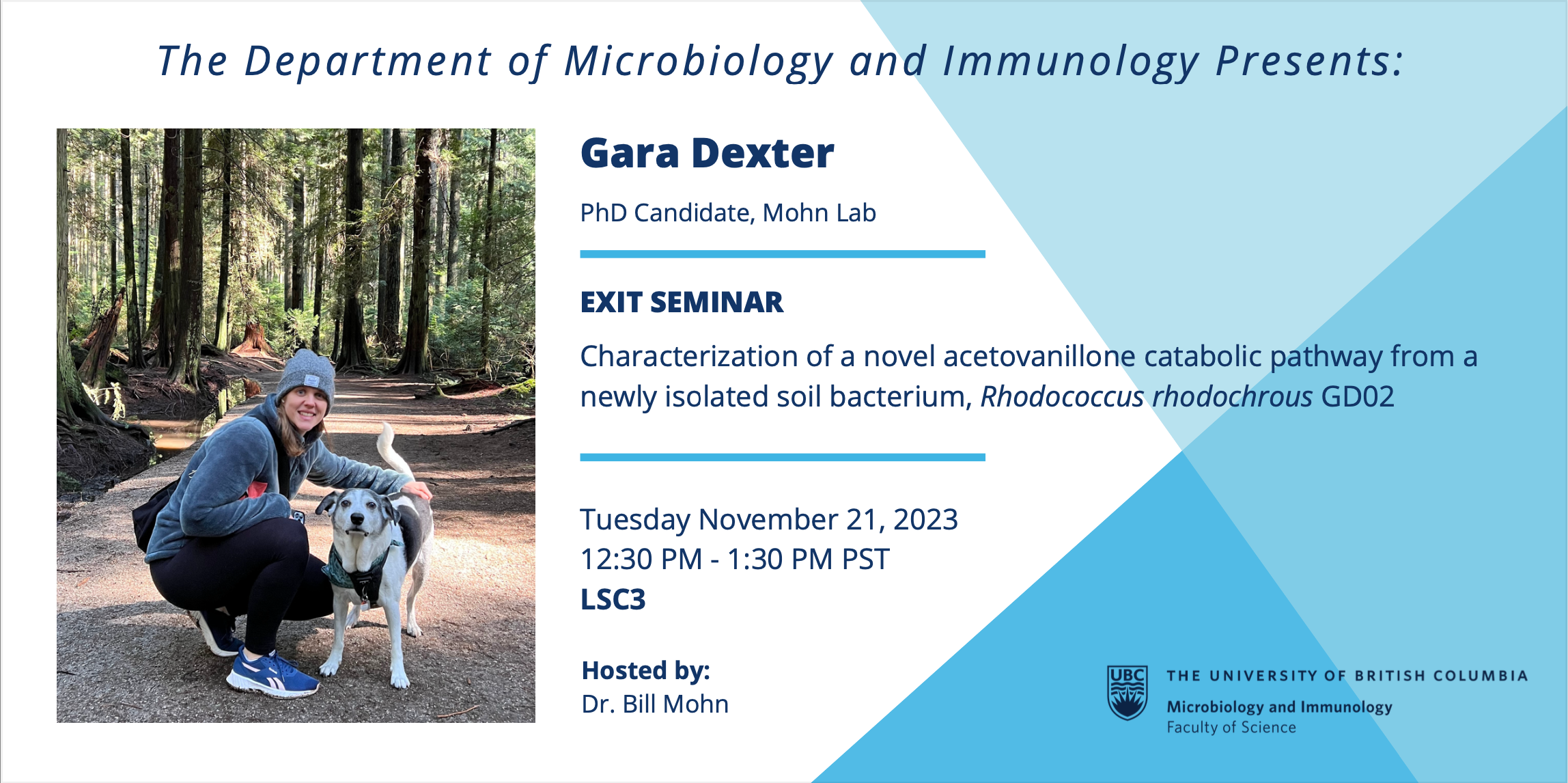
Seminar Title: Characterization Of A Novel Acetovanillone Catabolic Pathway From A Newly Isolated Soil Bacterium, Rhodococcus Rhodochrous GD02
Seminar Abstract: Bacteria are uniquely capable of catabolizing the aromatic compounds generated during lignin depolymerization, however, many of these catabolic pathways have not yet been elucidated. Acetovanillone, a key component in various industrial lignin streams, including black liquor from the Kraft pulping process and oxidative catalytic fractionation of softwood biomass, has been a focus of our research. We enriched bacteria from compost capable of growth on acetovanillone as the sole carbon source. Two Rhodococcus rhodochrous strains, GD01 and GD02, were isolated and theirgenome sequences were analyzed for genes encoding potential aromatic catabolic pathways. The strains have an ANI of 99.1% and, in accordance with their highly similar genomes, can utilize the same profile of aromatic substrates. However, GD02 grew on higher concentrations of acetovanillone and vanillin. A high-quality closed genome assembly of GD02 was generated by combining short and long-read sequence data, revealing a circular 5.58-Mb circular chromosome, a 721-kb linear plasmid and a 165-kb circular plasmid. To gain further insight into the ability of GD02 to grow on AV, we performed transcriptomic experiments with cells grown on AV, HAP, AP, and as a control, citrate. We identified a cluster of eight genes up-regulated during growth on acetovanillone (>150-fold) and 4-hydroxyacetophenone (>500-fold). Bioinformatic analyses predicted that this hydroxyphenylethanone (Hpe) pathway is unusual in that it proceeds by phosphorylation and carboxylation, before β-elimination yields vanillate from acetovanillone or 4-hydroxybenzoate from 4-hydroxyacetophenone. The kinase (HpeHI), carboxylase (HpeCBA), and phosphatase (HpeD) were all shown to have their predicted activities on AV, HAP, and their respective intermediates. HpeHI belongs to a This study lays the foundation for designing bacterial strains with biocatalytic applications by revealing a previously undiscovered pathway for acetovanillone degradation.
LSC 3 (Life Sciences Institute - 2350 Health Sciences Mall) MBIM itsupport@microbiology.ubc.ca America/Vancouver publicSeminar Title: Characterization Of A Novel Acetovanillone Catabolic Pathway From A Newly Isolated Soil Bacterium, Rhodococcus Rhodochrous GD02
Seminar Abstract: Bacteria are uniquely capable of catabolizing the aromatic compounds generated during lignin depolymerization, however, many of these catabolic pathways have not yet been elucidated. Acetovanillone, a key component in various industrial lignin streams, including black liquor from the Kraft pulping process and oxidative catalytic fractionation of softwood biomass, has been a focus of our research. We enriched bacteria from compost capable of growth on acetovanillone as the sole carbon source. Two Rhodococcus rhodochrous strains, GD01 and GD02, were isolated and theirgenome sequences were analyzed for genes encoding potential aromatic catabolic pathways. The strains have an ANI of 99.1% and, in accordance with their highly similar genomes, can utilize the same profile of aromatic substrates. However, GD02 grew on higher concentrations of acetovanillone and vanillin. A high-quality closed genome assembly of GD02 was generated by combining short and long-read sequence data, revealing a circular 5.58-Mb circular chromosome, a 721-kb linear plasmid and a 165-kb circular plasmid. To gain further insight into the ability of GD02 to grow on AV, we performed transcriptomic experiments with cells grown on AV, HAP, AP, and as a control, citrate. We identified a cluster of eight genes up-regulated during growth on acetovanillone (>150-fold) and 4-hydroxyacetophenone (>500-fold). Bioinformatic analyses predicted that this hydroxyphenylethanone (Hpe) pathway is unusual in that it proceeds by phosphorylation and carboxylation, before β-elimination yields vanillate from acetovanillone or 4-hydroxybenzoate from 4-hydroxyacetophenone. The kinase (HpeHI), carboxylase (HpeCBA), and phosphatase (HpeD) were all shown to have their predicted activities on AV, HAP, and their respective intermediates. HpeHI belongs to a This study lays the foundation for designing bacterial strains with biocatalytic applications by revealing a previously undiscovered pathway for acetovanillone degradation.

